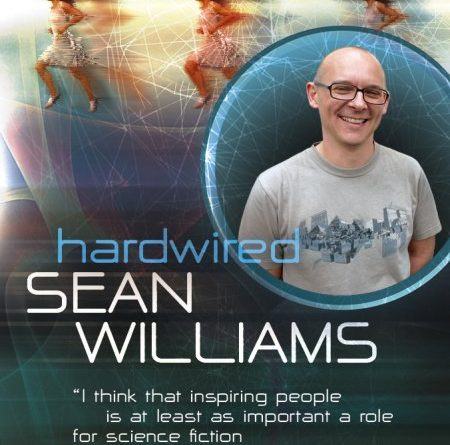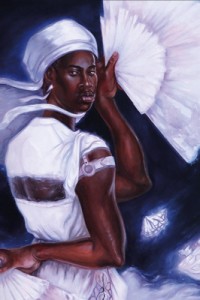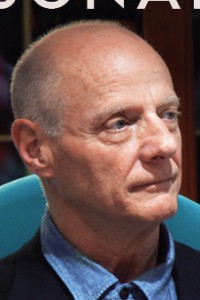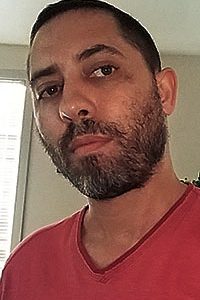Sean Williams: Hardwired
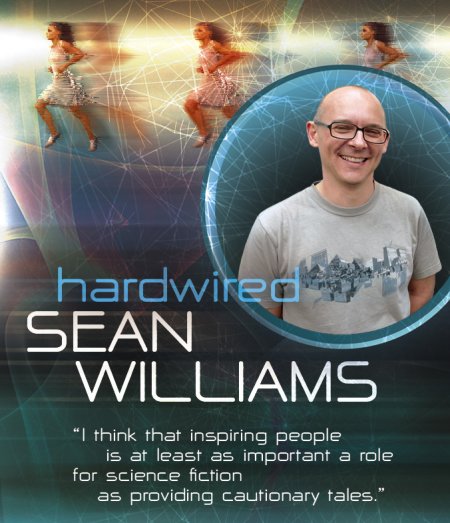
Sean Llewellyn Williams was born May 23, 1967 in Whyalla, South Australia, and grew up in South Australia and the Northern Territory. He focused more on music than writing when he was young, winning the Young Composer’s Award his final year at high school. He studied economics at university, but left in his third year, and went on to work as a sound engineer and in various other roles in the music industry while working toward writing for a living. He has been a full-time writer since 1990 (and making a living at it since 1999).
His first professional story sale was ‘‘Traffic’’ to Eidolon in 1992, the same year ‘‘Ghosts of the Fall’’ won third place in the Writers of the Future contest. He has published over 100 short stories and more than 40 books. His first novel was The Unknown Soldier (1995, with Shane Dix), which they later rewrote as book one in their Evergence series: The Prodigal Sun (1999), The Dying Light (2000), and A Dark Imbalance (2001). His first solo novel, Metal Fatigue, appeared in 1996, followed by The Resurrected Man (1998).
Other works include fantasy series Books of the Change: The Stone Mage & the Sea (2001), The Storm Weaver & the Sand (2002), and The Sky Warden & the Sun (2002); spin-off series Books of the Cataclysm: The Crooked Letter (2004), The Blood Debt (2005), The Hanging Mountains (20005), and The Devoured Earth (2006); the Orphans space opera series with Shane Dix: Echoes of Earth (2002), Orphans of Earth (2003), and Heirs of Earth (2004); the Geodesica space opera duology with Shane Dix: Ascent (2005) and Descent (2006); the Broken Land trilogy: The Changeling (2008), The Dust Devils (2008), and The Scarecrow (2009); the Astropolis space opera series: Saturn Returns (2007), novella Cenotaxis (2007), Earth Ascendant (2008), and The Grand Conjunction (2009); the Fixers middle-grade series: Castle of the Zombies (2010), Planet of the Cyborgs (2010), Cur se of the Vampire (2010), Invasion of the Freaks (2010); the Troubletwisters series with Garth Nix: Troubletwisters (2011; as The Magic in the US), The Monster (2012), The Mystery of the Golden Card (2013, as The Mystery in the US), and Missing, Presumed Evil (2014, as The Missing in the US); and the YA Twinmaker series: Jump (2013; as Twinmaker in the US), Crash (2014, as Crashland in the US), and Fall (2015, as Hollowgirl in the US).
He has written many Star Wars novels (some in collaboration with Shane Dix). Star Wars: The Force Unleashed (2008) was the first novelization of a computer game to debut at #1 on the New York Times bestseller list.
Williams’s short fiction has been collected in Doorway to Eternity (1995), A View Before Dying (1998), New Adventures in Sci-Fi (1999), Light Bodies (2007), and Magic Dirt: The Best of Sean Williams (2008). He’s won six Aurealis Awards, five Ditmar Awards, received the 2000 South Australia Great Award for Literature, and the 2009 Peter McNamara Award. He has taught at Clarion South, and is a judge for the Writers of the Future competition.
William lives in Adelaide, South Australia with his wife Amanda Nettelbeck.
Excerpts from the interview:
‘‘The Twinmaker series was my first attempt at writing YA science fiction. My other YAs were fantasy. I approached Twinmaker as a series of science fiction books, while at the same time approaching it as a YA project. One of the things my agent, my editor, and I worked on very carefully was making sure they were first and foremost YA novels, without sacrificing the science fiction elements. When I first sold the series I joked that I’d do an edition for the science fiction market that would have all the research in it – all the longer infodumps would go in that version – and maybe we could do an e-book edition where you could toggle between the two. What I discovered when I finished the first draft was that there was nothing in those infodumps that wasn’t in the book anyway, simply shown rather than told. When you’re writing adult space opera, like my last series, Astropolis, there’s so much more space. I recently went back and looked at those books and thought, ‘These paragraphs are so long, there’s so much explanation.’ It was rewarding to find a different way to approach those kinds of challenges.
‘‘Twinmaker’s main character, Clair, is 17. Throughout the series there are multiple version of her, at different stages in her life. The third book’s dedicated to my niece, Jessica Claire Sopp, and the fictional Clair is a reference to her. So is Clair’s boyfriend, Jesse. Jessica Claire Sopp, Jesse and Clair – it’s a double nod to her. She’s 25 now, which always shocks me. Growing up she was such a confident, smart, knowing teenager. I thought, ‘If only all teenagers were like her, there probably wouldn’t be any YA novels. People would just do stuff and it would work out well.’ I’ve always admired her. Clair in the book isn’t based on my niece, but there were many times when I thought to myself, ‘How would Jessica handle this? How would she approach a problem that seems intractable? How would she try to communicate with people?’ Clair doesn’t always do things the way my niece does, but Jesse was very much in my mind.”
…
‘‘Teleportation as a metaphor for contemporary connectedness is hardwired into the story. For Clair, electronic connectedness to media is so greatly taken for granted that it’s a bit like us and electricity. The dangers of electricity and the consequences of being cut off from electricity are things we don’t even think about anymore, whereas our relationship with media and the Internet is the contemporary concern. Today’s generation is younger than the Internet. They take it for granted, while their parents and grandparents struggle with the whole thing and think maybe they should be concerned. We have social teething problems with connectedness now, rather than technical ones, and Clair’s generation has those same teething problems with matter transfer devices. The technology’s not entirely perfected, and inevitably, once everybody adopts a technology and it becomes commonplace, unintended problems arise. That’s the parallel with sexting and the embarrassing photos on Face-book our kids are dealing with today.”
…
‘‘I didn’t want to portray matter transmitter devices as automatically evil, but instead as a technology that might have some downsides, depending on how it’s used. I certainly didn’t want to portray the world as a dystopia, because it’s not, as Clair knows it. The world becomes a dystopia because of people. People always screw everything up, and of course there are thousands of things that can plausibly go wrong with matter transmitters. When you take someone completely apart and put them together again over and over again, how can that not go wrong at some point? I’ve always been in love with the idea of matter transmitters, partly because of that. The first story I wrote was a matter transmitter story. It didn’t sell, of course, because it was terrible, but one of my first professional sales a year or two later was about matter transmitters, my second novel was about matter transmitters too, and many of my space operas contain matter transmitters. I just did a PhD about matter transmitters! In all, I’ve written about 30 books that have some kind of teleportation in them, and over 40 short stories.”
…
‘‘I think that one of the functions of science fiction – obviously this is not a new thought – is to examine the present through metaphors of the future. I had a couple of agendas for Twinmaker. One was, I want people to write more matter transmitter stories. I really like matter transmitter stories, and I’m tired of being the only one writing them. The other thing is politics and our monetary system. I didn’t plan to get into that originally, but I’m glad I did. I want teenagers to read, say, Crashland, and come out thinking, ‘Maybe a world without presidents and kings would be a great thing.’ Where everybody can contribute to running the government, if they want to. Where you don’t need to pay for things with money, so you don’t need to have a job. Wouldn’t it be great to do whatever you wanted for your life and be guaranteed that you could live, without that stress about survival in your life? Wouldn’t that revolutionize humanity? I want some 17-year-old to read these books and be inspired, and say to themselves, ‘I’m going to bring this revolution to the world.’ That would be pretty awesome. Would we end up like the people in Iain Banks’s Culture novels? That would be the perfect science fiction world for me, although maybe there’s something even better we haven’t imagined yet. I think that inspiring people is at least as important a role for science fiction as providing cautionary tales.”
…
‘‘I think it’s one of my great curses that I want to try things I’ve never done before. When I look back on my career, I sold that first space opera series that I co-wrote with Shane Dix to Ginjer Buchanan at Ace, and they did really well – they were Locus bestsellers. If I hadn’t wanted to try more hardcore space opera, along with young adult fantasy, and Star Wars novels, and more – and if I hadn’t done those things all at once – maybe I’d be Al Reynolds or Charlie Stross. But I’m Sean Williams. My hundredth short story came out earlier this year. I have a great career, and I’m very grateful for it.’’
Read the complete interview in the November 2015 issue of Locus Magazine. Interview design by Francesca Myman.


